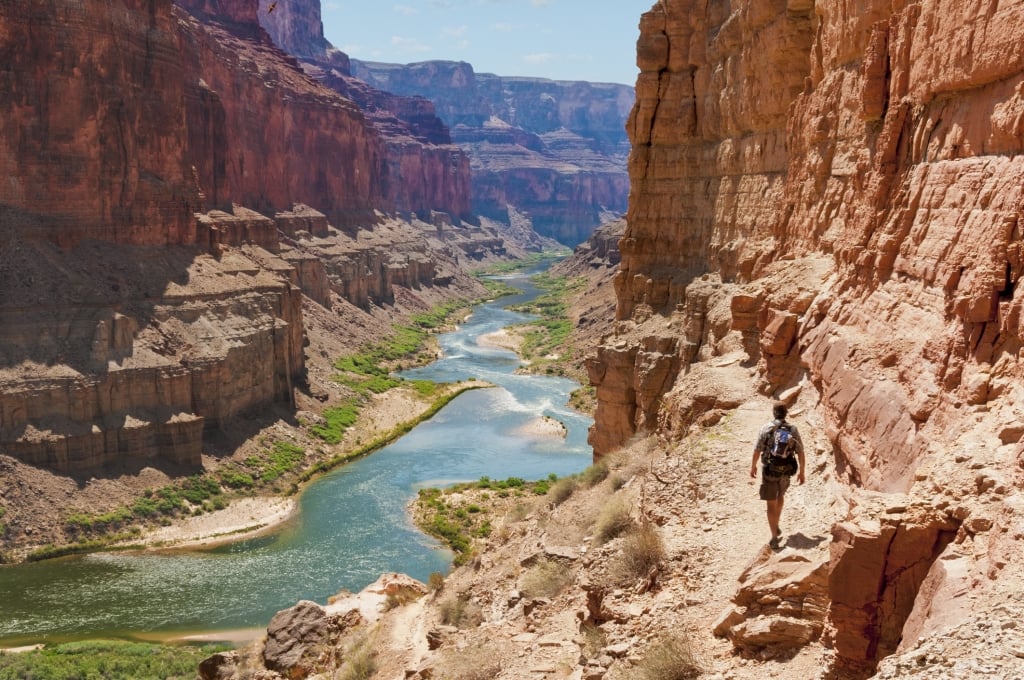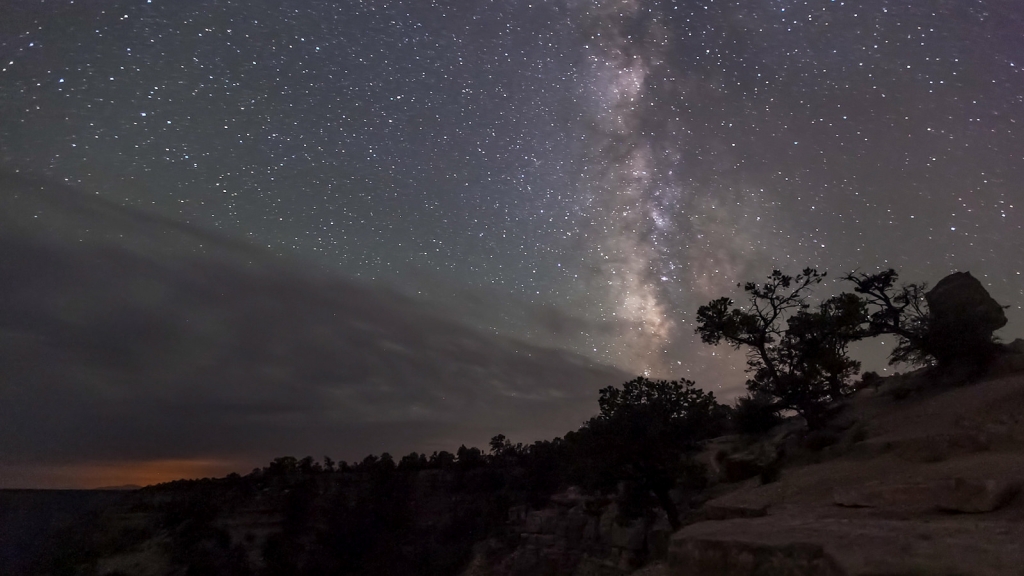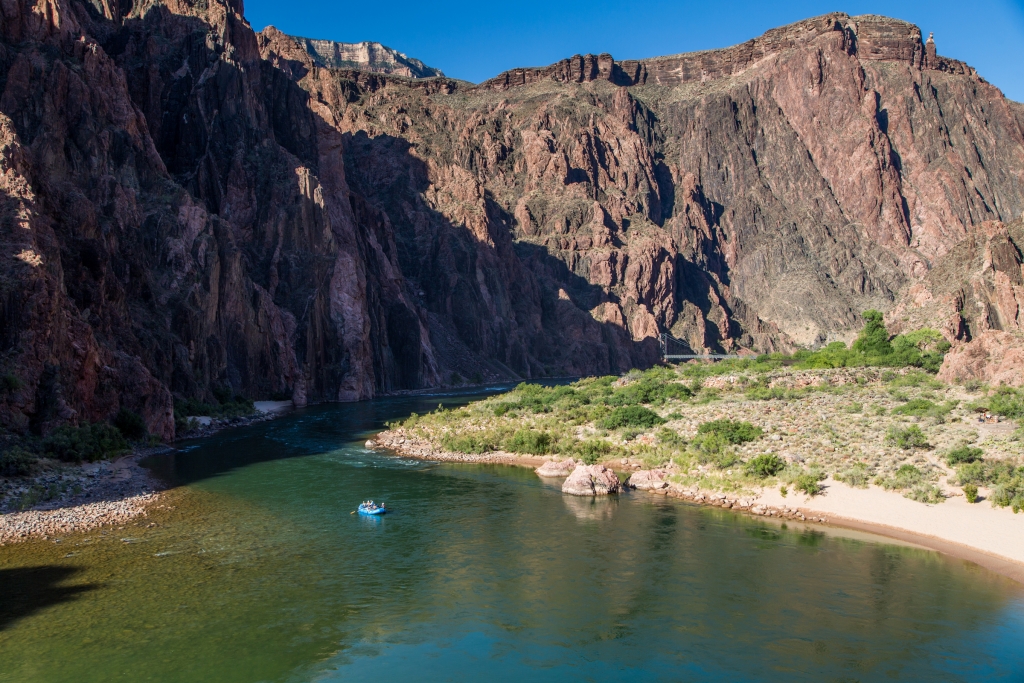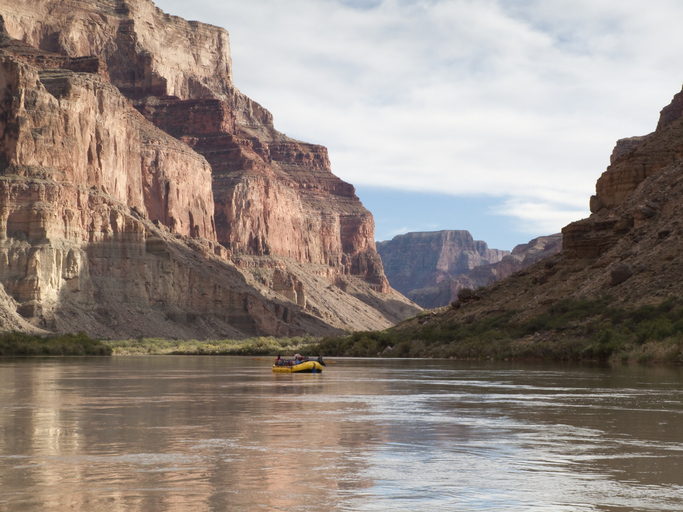A Trip Down the Colorado River Can Be Life Changing
“Who knew you could find Hawaii in the Grand Canyon?” my friend, Amy, says as we turn the corner walking along a high ledge above the Colorado River and pause to embrace the view. It’s been a sometimes-nervy hike, scrambling over rocks and haltingly navigating along a narrow ledge with a precipitous drop.
We’re above a slot canyon, gazing at twin waterfalls plunging over smooth tan rocks into a sunlit pool that feeds into another falls disappearing into the darkness below. The tan and sienna sandstone layers form a natural curved patio, softened by the bright green of cottonwoods and ferns sprouting from the walls.
Here, nearly a mile deep in the canyon, we’re enveloped by an oasis. As our group has rafted down the Colorado River and deeper into the Grand Canyon, we’ve been rewarded with one majestic pleasure after another.
Looking down into the canyon is like viewing a Hudson Valley landscape painting. You’re a spectator with a breathtaking view, awed but distant. Rafting through the canyon over six days is living inside one of those paintings, seduced day after day by its most intimate treasures. It’s a rare chance to experience a nearly pristine wild place as an adventurer, albeit a pampered one.
The cliché about travel, especially adventure travel, is that it transforms you, that you come back seeing places and people with new eyes.
Spend six days on the Colorado River and it’s impossible not to return with a fresh perspective. The river and the canyon strip away modern distractions. The 13-foot waves of the biggest rapids are humbling. The slot canyons with their layered walls are intimate rooms, each different, but welcoming. And every night we sleep under a sky dotted with thousands of stars, the dust of the Milky Way, and a moon so bright it creates deep shadows. You can imagine yourself as one of the Native Americans who first roamed the canyon about 8,000 years ago.
On a raft, the canyon surrenders its treasures slowly. The passage of time is marked around every corner, with every new strata of rocks hundreds of millions of years in the making.
“The glories and the beauties of form, color, and sound unite in the Grand Canyon — forms unrivaled even by the mountains, colors that vie with sunsets, and sounds that span the diapason from tempest to tinkling raindrop, from cataract to bubbling fountain,” John Wesley Powell wrote after his near-disastrous 1869 trip, finished by only seven of the original 10 explorers.

The View from the River
At Lee’s Ferry, mile zero of our 187-mile adventure, we pack our bags onto the J-rigs, boats designed and used by Western River Expeditions, our guiding company, for nearly 50 years. They’re odd-looking contraptions, five elongated rubber pontoons lashed together with frames holding coolers and storage boxes on top and a motor at the rear. Our trip leader and boatwoman is Veronica “Ronnie” Haymond, a veteran of 20 years and 120 trips down the river. The boatman on the other J rig is her husband, Jeff Haymond.
“There’s that iconic idea of what the Grand Canyon is,” Ronnie says when we talk after the trip. “That big view from the top. You see all these big rocks, but you don’t get the sense there are these little oases down there. You hardly see the river at all.”
This week we will become part of the river, riding boats that hold 14 people and two crew, the boatman and the junior member, called the “swamper.” On board in the persistent rain, Ronnie explains seating and safety. Up front you can ride the pontoons, hooking one hand under a rope in front and the other under a rope behind you, like a river cowboy riding a bucking rapid. It’s like sitting on your car’s hood going through a carwash, one blast of cold water after another. Mid-boat are coolers covered by padding, where you’ll still get wet, but the ride isn’t as wild. In the rear is the chicken coop, padded seating atop storage boxes where only occasionally an ambitious wave will wash over you.
No one, she says, will fall overboard, right? But if you do, she adds, the crew will use hand signals because of the roar of the water. A motion towards the boat means swim to the rig. A motion away means stay away for now, it’s not safe to come aboard. And a thumbs up means good luck, you’re swimming the rapid and we’ll pick you up downstream.
Before every rapid — and there were dozens of them over six days — Ronnie offers a scouting report, complete with a rating up to 10 based on how hard each is to navigate and the size of the whitewater.
She also provides a running commentary of history, geology, and folklore. About 6 million years ago, the Colorado began carving the canyon. Early in the float, tawny Cocino sandstone dominates, but as we get deeper and deeper, the layers increase in complexity and variation from the light shale to limestone to Zoroaster Granite to Vishnu Schist, which resembles swirls of thick ebony frosting. Soon, the walls rise thousands of feet above us.
At times, we slip into pockets of fog rising off the river, blasts of cool, then hot air as we pass by sheer rock walls and slot canyons entering from the side. The water becomes increasingly muddy downstream, though the temperature — a brisk 50 degrees — does not change.
Early on the second day, we make a play stop at Redwall Cavern, a dramatic chamber large enough to play football or throw a Frisbee that John Wesley Powell thought could hold 50,000 people (it’s big, but his eyes deceived him). We pass Vasey’s Paradise, where a waterfall, diminished by the drought according to Ronnie, bursts out of the canyon wall, framed by greenery.
Before the falls, though, there is a day of rapids. We can hear them in camp that night, right around the corner, ominous and vaguely threatening.
Nevills Rapid, named after the first man to offer commercial river trips through the canyon, is our first ride. There are also Hance and Sockdolager, named by John Wesley Powell using a 19th-century colloquialism for knockout punch. We take a break to pick up fresh water at Phantom Ranch, where hikers from the South Rim can spend the night.
Back on the river, we’re back on the roller coaster, bucking through Horn Creek and Boucher Rapid, short bursts of hard action before another big one, Crystal Rapid, known as the deadliest stretch of water in the canyon. This time, Ronnie’s pre-rapids talk is stern. “No one is swimming Crystal,” she says, emphasizing that everyone must have a good hold of straps. She takes a perfect line through Crystal. We emerge soaking wet, but it’s a fun, safe ride.The day of bronco busting on the raft is rewarded when we pull into the most stunning campsite of the trip, a sprawling, tiered area with a scalloped shale wall as the backdrop. Amy and I decide to set up our cots under the sky in the penthouse, high above the beach next to the wall, brushing aside worries about residual heat and critters for the spectacular panorama.

Nights Under the Milky Way
Each afternoon we unload the boats in a fire line, set up our cots and tents, if using them, and wait for the call for appetizers. Then we set up our chairs along the beach and enjoy one of the beers — Grand Canyon Black IPA for us — that everyone has stowed aboard and that cools in the river.
It’s a diverse group on the trip, including a lot of extended families, grandfathers and fathers and sons. We talk with Maeda and Jon and their son, Sam, a college student, about disconnecting from technology and changing careers. With another rafter, John, who works for a Northern Virginia auto dealer, Amy finds a kindred bicycling soul. One night, Russ, who lives in the mountains of western North Carolina and served in Vietnam, tells us the moving story of finding a baby in a rice paddy and persevering to adopt her and bring her to the United States.
The meals are surprisingly good and sprinkled with surprises — a shrimp cocktail appetizer, steaks on a grill, freshly made ice cream. After dinner, people wander back to their sleep sites steps away, the path lit by headlamps. That’s what Amy and I did on this night, climbing to the penthouse to sit on chairs outside our tent and sip Makers Mark on the rocks as one star after another and then the Milky Way magically materialized overhead.
We talk about past disappointments and future hopes, telling stories we’ve never shared. We embrace the silences, watching for shooting stars and the rise of the moon over the rim, a moon so bright it casts long, dark shadows.

The Relativity of Time and Place
Days on the river pass without trivial distractions, spawning moments of reflection. Time accordions, fast and furious during the day, slow and contemplative at night.Nature dictates the schedule, a schedule of simpler times. We rise with the moon still high in the sky, clambering out of sleeping bags for cowboy coffee, packing up, and then sharing breakfast with the first light of dawn. We go to sleep soon after darkness curtains the canyon. Our day of rapids is followed by a day of slot canyons and waterfalls, just as Ronnie promised.
We navigate one of those rapids, Dubendorf, which Ronnie describes as one of the hairiest for a boatman because there’s no good way through it. She manages just fine. Still wet from Dubendorf, we put in at Stone Creek, where a wide waterfall is a cooling midday respite.
But that’s only an appetizer for the day’s best stop, Deer Creek, four miles down the river.
There, a thunderous waterfall roars over the edge of a slot canyon. About half of the group follows Jeff for the 30-minute hike high over rocks along narrow ledges with heart-pumping drops to the oasis, that bit of Hawaii in the Grand Canyon, as Amy puts it. We play in a series of small waterfalls, enjoy a snack, and take a short hike into the valley above to look at the remains of an ancestral Pueblo structure a thousand years old.
Deer Creek, as it turns out, is only an appetizer to the main course the next day, Havasu Creek, a sublime playground with fantastical blue water where we spend hours hiking along the water’s edge, playing in the pools, and just sitting on the warm rocks, enchanted by the beauty.
Back on the river late in the afternoon, there’s one more big rapid, the notorious class 8 (of 10) Lava Falls. We hear the roar before we see the haystacks of water and the rolling waves. It’s a quick thrill, expertly negotiated by Ronnie. That night, Jeff, Ronnie, Scott, and Maekala wear formal dresses and tuxes — or approximations of tuxes — and serve shrimp cocktail as the appetizer for the final meal.Ronnie tells us to scoop up some sand — “Grand Canyon spice,” she calls it — and take it home, keeping the river with us, sprinkling it over our food, in our sheets, shoes, and everything else. Her suggestion earns a few chuckles. By now, sand is in everything.
We take a helicopter from a small dirt pad along the river early the next morning, then a plane back to Las Vegas, but leaving the trip behind isn’t that simple. I’ve been on other trips to isolated places — the bush of Zambia, the slot canyons of Lake Powell, the rainforest of Costa Rica — and each time the trips linger, pushing me to travel more deeply into those places even after I am comfortable — perhaps too comfortable — again in my reading chair.
When I return home, I dive into a book of essays about the canyon and go through my photographs again and again. I venture online to look for a quote that captures the experience, finding one from young-adult author, Terry Pratchett, in a book titled A Hat Full of Sky.
“Why do you go away?” he writes. “So that you can come back. So that you can see the place you came from with new eyes and extra colors. And the people there see you differently, too. Coming back to where you started is not the same as never leaving.”
For more information, visit grandcanyonlodges.com or call 888-297-2757 for assistance on booking a rafting tour.
For more travel experiences available from Xanterra Travel Collection® and its affiliated properties, visit xanterra.com/explore.


